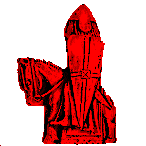Piececlopedia: Knight
Historical notes
The Knight has remained the same since Chaturanga, which is widely regarded as the first form of Chess. Its original Sanskit name is asva or ashwa, which meant horse. The Persians called it an asp, and the Arabs called it a faras, both words meaning horse. When Chess reached Europe, the concept behind Chess became a royal court rather than a battlefield, and the horse was rechristened as a Knight, which had a place in a royal court, and which normally rode upon a horse. Since all warriors at the time rode horses, the piece was sometimes just called a miles, which meant soldier. The Germans called it Ritter, which means rider, but later took to calling it Springer, which means jumper. Except for Iceland, which got Chess from Britain, the Scandinavian countries used the German name of Springer. In European languages, the piece is often called by the word for horseman, rider, knight, or jumper. The French call it a cavalier, which means knight. Outside of Europe, but also in parts of Europe, it is normally known by the word for horse. For example, the Spanish call it caballo, which means horse.
The Horse of Xiangqi and the Honorable Horse of Shogi move in the same way as the Knight, except that they have more limited powers of movement. They are both described on other pages.
Movement
The Knight leaps to any space that can be reached by moving one space orthogonally, followed by another space diagonally outward, or vice versa. When spaces are squares, this is normally understood as moving in an L shape by moving two spaces in the same direction, followed by one more space after turning at a right angle. Or one square, turn at a right angle, and move two more squares. On a hexagonal board, it is almost like this, except that the turn is 60 degrees left or right, not 90 degrees. The Knight leaps over any intervening pieces, as though they weren't even there. In Chess and most usual Chess variants, a Knight can move to an empty space or take an enemy piece by moving to its space, but it may not move to a space already occupied by a friendly piece.
Movement Diagrams
|
|

|
Vocabulary: Hippogonal
A Knight leaps hippogonally. This word comes from the Greek hippos, which means horse. It has nothing to do with moving like a hippopotamus. Like the koala bear and the guinea pig, the hippopotamus was named after something it's not. Its name literally means a horse that lives on the banks of a river. So, remember, hippo- means horse, not hippo. Anyway, a hippogonal move is one that reaches the same spaces that a Knight can move to. This has been described above, and you will remember that the Knight used to be called a horse, and still is in some languages. The Knight is a hippogonal leaper. The Chinese Chess Knight is a hippogonal stepper. The Nightrider is a hippogonal rider.
Checkmating
The Knight cannot inflict checkmate on a rectangular board with only assistance of its own King, and is thus a minor piece. Even with a pair of Knights you cannot force checkmate on a bare King, because the required placement of its own King prevents it from using its 'forking' power to attack corner and edge square. Paired with another minor forcing mate is sometimes possible. Try it!
Alternate Images
Click on an image to view the full piece set it belongs to.
 |
||
References
Davidson, Henry A. A Short History of Chess, 1949.
Murray, H. J. R. A History of Chess, 1913.
This is an item in the Piececlopedia: an overview of different (fairy) chess pieces.
Written by Fergus Duniho and Hans Bodlaender. Diagram by Ben Good.
WWW page created: September 4, 1998. Last modified: December 14, 2001.
